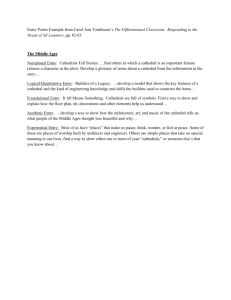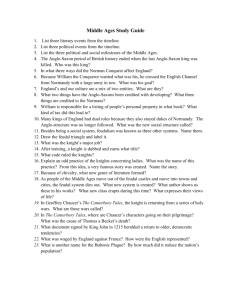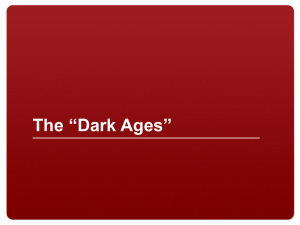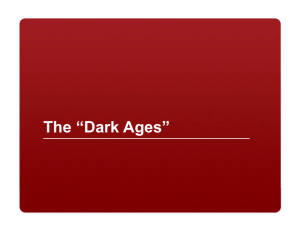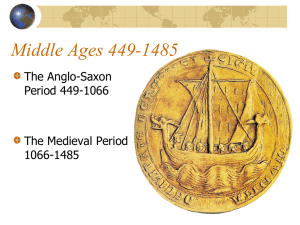High Middle Ages
advertisement
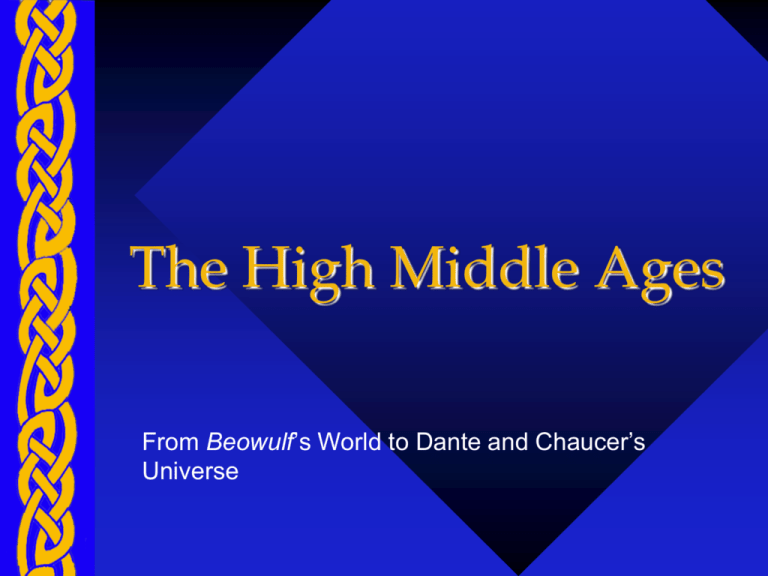
The High Middle Ages From Beowulf’s World to Dante and Chaucer’s Universe When people discuss “the Dark Ages,” they typically mean the Low Middle Ages. (That means the crazy centuries just after the fall of Rome in 455.) However, the late medieval world is quite strikingly different from the earlier one. 800 CE = the time of the Charlemagne’s Empire, which unifies France and Germany under his kingdom 1066 CE = the time of William the Conqueror’s conquest of England On the continent, this later period is called The High Middle Ages to contrast it with the earlier Low Middle Ages. In England, scholars may use the term “Anglo-Saxon period” to refer to the Low Middle Ages and the term “Middle English period” to refer to the High Middle Ages. The Low Middle Ages is a time of Germanic tribes sweeping across Europe, of Viking invasions, of small tribal kingdoms fighting in war bands. It’s a chaotic, lawless time. Here, we have the mast of a Viking longboat. Note the dragon imagery, O ye readers of Beowulf! Roman architectural technology is lost. Many early churches are simply crammed into ruins of old Roman temples. Temple of Clitumnus,a Christian church established about the year 650 in northern Italy. The architecture was in a style called “Romanesque.” It had some superficial Roman features, but short and squat. The Tomb of King Theodoric, barbarian ruler over Italy, built before 526 C.E. Ravenna, Italy. So how do we get from this . . . . The Tomb of King Theodoric, barbarian ruler, built before 526 C.E. Located in Ravenna, Italy. …to this? Lincolnshire Cathedral, England, c. 1200 …or Canterbury Cathedral? Or this? Choir at Canterbury Cathedral. Note the Roman arches combined with gabled ceilings. Note how tall it is! From Anglo-Saxon manuscripts like this. . . . First page of the Nowell Codex (the Beowulf manuscript) Cotton Vitellius A.xv, produced circa 800 CE, To gold-encrusted books like this? Gold-illuminated lettering for Psalm 1:1 “Beatus Vir,”from Dagulf’s Psalter. Created in the court school of Emperor Charlemagne. Östreichische National Bibliothek, Vienna, Codex 1861, fol. 25 r, 9th century. Or rubricated books like this one? Illuminated initial “E” depicting the prophet Ezekiel, eating the bitter scroll from the angel before his vision. Or artistic talent like this monk’s? Illumination for Psalm 23. From ninth-century Psalter, from Saint-Germaindes-Prés. Württembergische Landesbibliothek, Stuttgart, Bibl. Fol. 23. To texts that combine all these lovely techniques in a riot of detail? Unicorn Psalter, circa 1200 from France. Note the detail in the historiated initial and the babuins or grotesques in the margins. We move from an age of Anglo-Saxon war chiefs and Viking pirates . . . The “Sutton Hoo” helmet of an Anglo-Saxon cyning or thegn, dating to early 600, found near Suffolk, England. To the romanticized glory of late feudal monarchy. Statuary over Sarcophagus of King Henry IV and his wife, Joan of Navarre, from Canterbury Cathedral’s crypt. That is the question for today. Display armor from Belvoir Castle in England. We start with these contrasts-Religion? (Paganism fades) Tripartite Social Structure? Technology? (moldboard plow, better timber production) Population Growth? Carolingian Development? Politics? (Tribal-->Feudal) •Rise of The Knight •Vassalage •Cavalry and stirrups •Lance Charge •Crossbow leads to Platemail armor •Courtly Love--code of polite behavior amidst the court •Chivalry--code of behavior on the battlefield Monastic Knowledge •cathedral schools •literate clergy •scriptoria •summae •bestiaries, botanical guides, astrology charts, lapidaries, numerological treatises, scriptural glossation •Fourfold Interpretation Fourfold Interpretation •Literal level •Allegorical level (especially types and antitypes) •Tropological level (moral lesson) •Anagogical Level (eschatological mystery)

